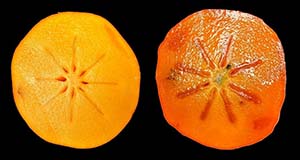Abstract
Persimmon fruits are classified as astringent or non-astringent, depending on the level of astringency the unripe or partially ripe fruit exhibit at the time of harvest. Astringency in persimmon fruit is a sensation caused by tannins present in the flesh that can make the mouth feel dry, cause puckering, numb the tongue, and constrict the throat. Sometimes, it may also impart a bitter taste. The astringency decreases as the fruit ripen until it is no longer present in fully ripe fruit. While consumers typically prefer non-astringent varieties, the cultivation of astringent varieties notably remains common. The purpose of this publication is to introduce consumers, growers, Extension agents, and specialists to postharvest methods for reducing astringency in unripe persimmons, making them more palatable and acceptable for consumption.

This work is licensed under a Creative Commons Attribution-NonCommercial-NoDerivatives 4.0 International License.
Copyright (c) 2024 UF/IFAS

